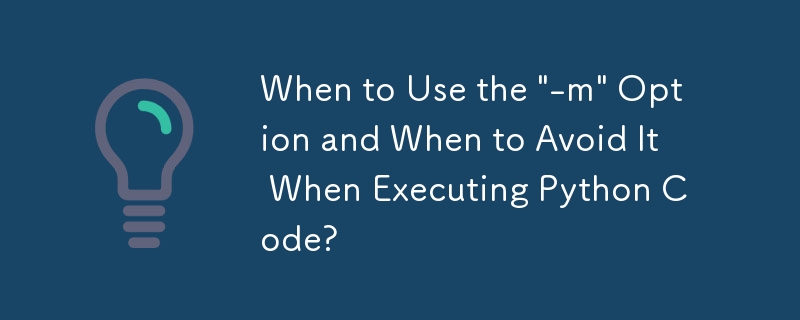Home >Backend Development >Python Tutorial >When to Use the \'-m\' Option and When to Avoid It When Executing Python Code?
When to Use the \'-m\' Option and When to Avoid It When Executing Python Code?
- Patricia ArquetteOriginal
- 2024-10-22 22:50:29482browse

Execution of Python Code with the -m Option and Without
The Python interpreter offers the -m option, which allows you to execute a library module as a script. However, it raises questions about the differences between using and not using the -m option.
Differences in Invoking Python Code
When you invoke a Python code, such as a.py, without the -m option, the file is treated as a script. On the other hand, using the -m option, the interpreter imports the specified module as a script before executing the main script.
This distinction is crucial when dealing with packages. Running a package with python foo/bar/baz.py will differ from using python -m foo.bar.baz. In the latter case, the foo.bar package is imported, enabling relative imports.
package and name
The __package__ attribute provides the name of the package containing the module. When invoking a script directly, __package__ is set to None, as the file is not part of a package. However, when using the -m option for a module within a package, __package__ is set to the package name (e.g., 'foo.bar').
The __name__ attribute refers to the name of the current module. It is set to '__main__' when executing a script, and remains the same even when invoking a module with the -m option.
David Beazley's Explanation
David Beazley describes how the -m option runs a library module as a script within the __main__ module before executing the main script. This means that the script's global namespace is placed within the __main__ module, and the __name__ attribute refers to this module.
Practical Differences
Using the -m option can provide the following benefits:
- Importing Modules: It automatically imports the specified module and treats it as the script to be executed.
- Relative Imports: It enables relative imports within packages.
- Package Execution: It allows packages to be run as scripts by creating a __main__.py module within the package.
However, using the -m option can also have some limitations:
- Script-Only Execution: You cannot execute standalone scripts with the -m option.
- Namespace Conflict: If there is an existing __main__ module in the script's directory, it can lead to namespace conflicts.
Overall, choosing between using or not using the -m option depends on the specific requirements of the Python code you are executing and whether you need to import modules, enable relative imports, or run packages as scripts.
The above is the detailed content of When to Use the \'-m\' Option and When to Avoid It When Executing Python Code?. For more information, please follow other related articles on the PHP Chinese website!

